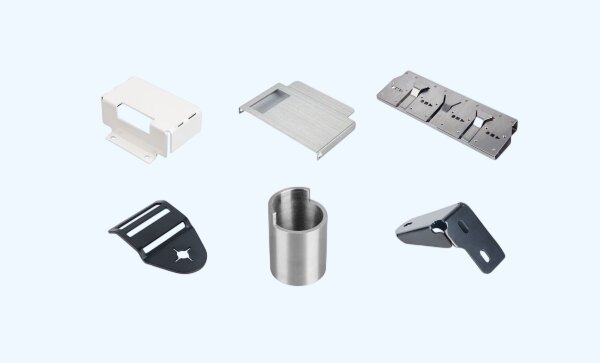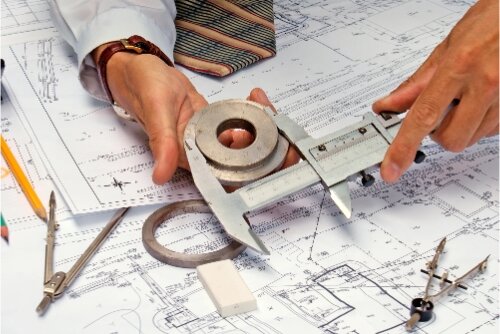يواجه مصنعو السيارات ارتفاع التكاليف وضيق جداول الإنتاج. ويكافح الكثيرون للعثور على خدمات تصنيع الصفائح المعدنية الموثوقة التي تقدم قطعًا عالية الجودة في الوقت المحدد. يساعد المزيج الصحيح من التقنيات والمواد على إنشاء مكونات سيارات متينة مع الحفاظ على انخفاض التكاليف.
يستخدم تصنيع الصفائح المعدنية للسيارات تقنيات القطع والثني واللحام لتشكيل المعادن في قطع السيارات. وتشمل المواد الشائعة الصلب والألومنيوم والتيتانيوم. وتتميز كل مادة بخصائص فريدة تناسب أجزاء معينة، مثل ألواح أو إطارات الهيكل.
تحتاج صناعة السيارات إلى نماذج أولية من الأجزاء الأولية للتصميمات الجديدة والمكونات المنتجة بكميات كبيرة لتجميع السيارات. دعونا نفحص تقنيات التصنيع الرئيسية والمواد التي تجعل هذا الأمر ممكنًا.
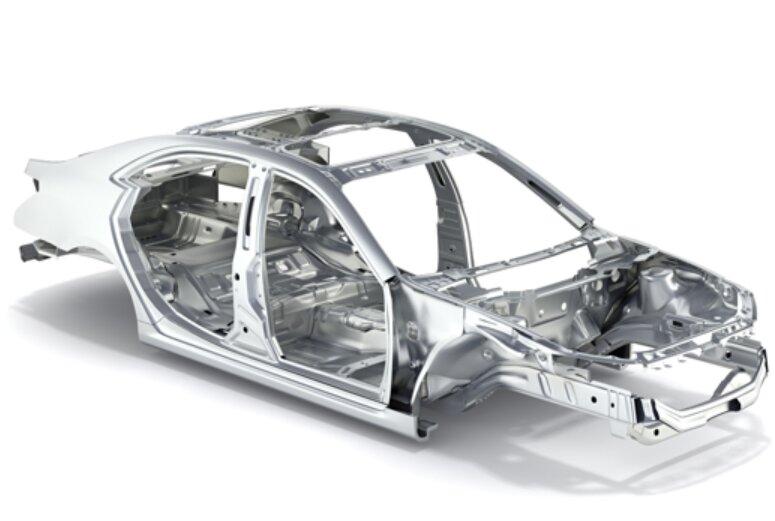
ما هو تصنيع الصفائح المعدنية للسيارات؟
تتضمن عملية تصنيع الصفائح المعدنية للسيارات قطع الصفائح المعدنية وثنيها وربطها لتصنيع أجزاء السيارة، بما في ذلك ألواح الهيكل والإطارات والمكونات الهيكلية. تبدأ العملية بصفائح معدنية مسطحة يتم تحويلها إلى أشكال ثلاثية الأبعاد باستخدام أدوات وتقنيات متخصصة.
تُستخدم هذه الطريقة على نطاق واسع لأنها فعالة وتنتج أجزاء عالية الجودة. وهي تسمح للمصنعين بإنشاء تصميمات معقدة مع الحفاظ على القوة والمتانة.
لماذا تختار تصنيع الصفائح المعدنية في صناعة السيارات؟
لعدة أسباب, تصنيع الصفائح المعدنية خيارًا شائعًا في صناعة السيارات. فهي توفر الدقة والمرونة والفعالية من حيث التكلفة، مما يجعلها مثالية لإنتاج قطع غيار السيارات. دعونا نفصل الفوائد الرئيسية.
الانضباط و الدقة
تتطلب السيارات الحديثة قطعاً تتناسب مع بعضها البعض بشكل مثالي. يستخدم تصنيع الصفائح المعدنية أدوات متقدمة مثل قواطع الليزر وماكينات التحكم الرقمي باستخدام الحاسوب لتحقيق دقة عالية. وهذا يضمن أن كل قطعة تفي بالمواصفات الدقيقة، مما يقلل من الأخطاء ويحسّن الجودة الشاملة.
مرونة التخصيص والتصميم
تتطور تصاميم السيارات باستمرار. يتيح تصنيع الصفائح المعدنية إمكانية التخصيص، مما يجعل إنشاء أشكال وميزات فريدة من نوعها أمراً سهلاً. يمكن لهذه الطريقة التعامل مع مختلف التصميمات، سواء كانت لوحة هيكل أنيقة أو إطاراً معقداً.
إنتاج فعال من حيث التكلفة
يمكن أن يكون إنتاج قطع غيار السيارات مكلفاً، ولكن تصنيع الصفائح المعدنية يساعد على خفض التكاليف. فهو يستخدم المواد بكفاءة ويقلل من النفايات. كما تعمل العمليات الآلية على تسريع الإنتاج، مما يوفر الوقت والمال.
الأجزاء خفيفة الوزن
يؤدي تقليل وزن السيارة إلى تحسين كفاءة استهلاك الوقود والأداء. يستخدم في تصنيع الصفائح المعدنية مواد خفيفة الوزن مثل الألومنيوم، وهي مواد متينة وليست ثقيلة. وهذا يجعل السيارات أكثر كفاءة دون التضحية بالسلامة أو المتانة.
متانة المكونات وطول عمرها الافتراضي
تواجه السيارات ظروفاً قاسية، بدءاً من الطقس القاسي ووصولاً إلى الطرق الوعرة. يصنع تصنيع الصفائح المعدنية قطعاً متينة تدوم طويلاً. تقاوم مواد مثل الفولاذ والتيتانيوم البلى والتلف، مما يضمن بقاء السيارات موثوقة لسنوات.
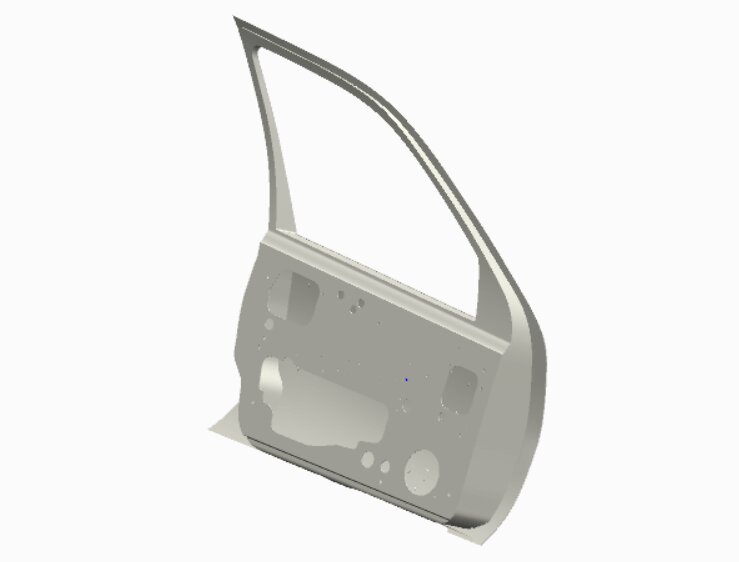
أنواع مكونات الصفائح المعدنية للسيارات
تُعد مكونات الصفائح المعدنية للسيارات ضرورية لهيكل السيارة ومظهرها. ويتم تصنيعها باستخدام تقنيات تصنيع مختلفة لتلبية معايير السلامة والمتانة والتصميم.
لوحات الجسم
تشكل ألواح الهيكل الغلاف الخارجي للسيارة وتتضمن أجزاء مثل الأبواب وأغطية المحرك والسقف والرفارف. تساعد مواد مثل الفولاذ عالي القوة أو الألومنيوم في الحفاظ على وزن السيارة خفيفاً مع ضمان قوة الألواح ومقاومتها للصدأ.
أجزاء الهيكل والإطار
يشكّل الهيكل والإطار العمود الفقري للسيارة. تدعم هذه الأجزاء وزن السيارة وتوفر لها القوة. وهما مصنوعان من مواد صلبة مثل الفولاذ عالي القوة لتحمل ضغوطات القيادة اليومية مع الحفاظ على سلامة السيارة.
التعزيزات الهيكلية
تضيف التعزيزات الهيكلية قوة إضافية للإطار والهيكل. تساعد هذه الأجزاء على امتصاص الصدمات أثناء التصادم وحماية ركاب السيارة. تُنشئ طرق التصنيع مثل الختم واللحام هذه الأجزاء بدقة عالية.
مكونات الهيكل السفلي وأسفل الهيكل
تشمل المكونات الموجودة أسفل الهيكل وأسفل الهيكل نظام العادم وحوامل المحرك. يجب أن تكون هذه الأجزاء قوية لتتحمل الحرارة والتآكل. وتساعد تقنيات التصنيع مثل القطع والثني بالليزر على ضمان ملاءمة هذه الأجزاء بشكل مثالي وعملها بشكل صحيح في الظروف القاسية.
أنواع الصفائح المعدنية المستخدمة في تصنيع السيارات
يعد اختيار النوع الصحيح من الصفائح المعدنية أمرًا ضروريًا في تصنيع السيارات. يوفر كل معدن مزايا مختلفة، بما في ذلك القوة والوزن والمتانة. فيما يلي بعض المعادن الأكثر شيوعاً المستخدمة في تصنيع السيارات.
الفولاذ المقاوم للصدأ
الفولاذ المقاوم للصدأ قوي ومقاوم للصدأ. ويُستخدم عادةً للأجزاء التي تتحمل الضغط والظروف القاسية، مثل أنظمة العادم والمكونات الهيكلية. كما أن مقاومته للتآكل تجعله خياراً موثوقاً لقطع غيار السيارات.
الألومنيوم
الألومنيوم خفيف الوزن ولكنه قوي. وغالباً ما يُستخدم في ألواح الهيكل ومكونات المحرك. ويساعد هذا المعدن على تقليل الوزن الإجمالي للسيارة دون التضحية بقوتها. كما أن الألومنيوم يقاوم الصدأ، مما يجعله خياراً جيداً للأجزاء المعرّضة للعوامل الجوية.
الصلب المدلفن على البارد
يُصنع الفولاذ المدلفن على البارد من خلال تشكيل الفولاذ في درجة حرارة الغرفة. وتمنحه هذه العملية لمسة نهائية ناعمة وقوة عالية. وغالباً ما يستخدم في الأجزاء التي تحتاج إلى الدقة، مثل المكونات الهيكلية. كما أن الفولاذ المدلفن على البارد فعال من حيث التكلفة وسهل التشكيل.
صفيحة مجلفنة
يحتوي الفولاذ المجلفن على طبقة من الزنك تساعد على حمايته من الصدأ. ويستخدم عادةً في ألواح الهيكل والأجزاء السفلية المعرضة للرطوبة. كما أن الطلاء يجعله مقاومًا للتآكل، وهو أمر ضروري للأجزاء التي تواجه طقسًا قاسيًا.
التيتانيوم
التيتانيوم قوي وخفيف الوزن. وهو يقاوم التآكل، مما يجعله مثالياً لمكونات المحرك وأنظمة العادم. ومع ذلك، فإن التيتانيوم باهظ الثمن، لذلك يُستخدم في تطبيقات محددة عالية الأداء حيث تكون هناك حاجة إلى القوة والخفة.
المغنيسيوم
يُعد المغنيسيوم أحد أخف المعادن المتاحة. وغالباً ما يستخدم في قطع الغيار مثل العجلات وكتل المحرك، مما يساعد على تقليل وزن السيارة. ومع ذلك، فهو أكثر عرضة للصدأ ويحتاج إلى حماية خاصة.
النحاس والنحاس
يُستخدم النحاس والنحاس الأصفر في الأسلاك والمشعات وخطوط المكابح. النحاس معروف بتوصيله الممتاز، بينما النحاس الأصفر قوي ومقاوم للتآكل.
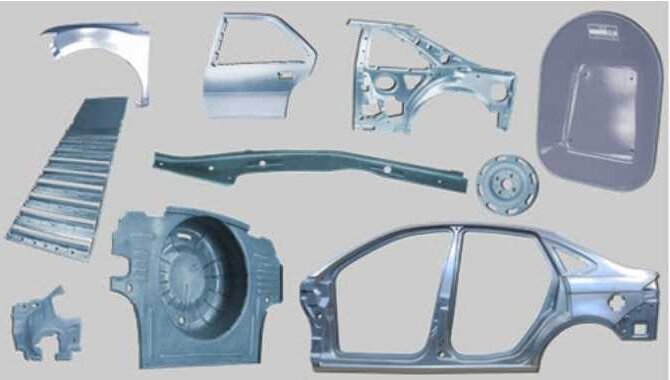
عملية تصنيع الصفائح المعدنية للسيارات
تتضمن عملية تصنيع الصفائح المعدنية للسيارات عدة خطوات لتشكيل المعادن في الأجزاء اللازمة للمركبات. وتغطي هذه الخطوات عمليات القطع والتشكيل والربط بين المعدن لإنشاء مكونات دقيقة تفي بالمعايير المطلوبة.
تقنيات قطع الصفائح المعدنية للسيارات
القطع هو الخطوة الأولى في تشكيل الصفائح المعدنية. يتم استخدام طرق مختلفة حسب المادة والتصميم.
القطع بالليزر
القطع بالليزر يستخدم شعاعاً ضوئياً مركزاً لقطع المعدن. يوفر دقة عالية وحوافاً ناعمة. تعمل هذه الطريقة بشكل جيد مع الصفائح المعدنية الرقيقة والتصاميم التي تتطلب الدقة.
قطع البلازما
قطع البلازما يستخدم شعلة بلازما ساخنة لصهر المعدن وقطعه. وهو أسرع من القطع بالليزر ولكنه قد يترك حوافاً أكثر خشونة. القطع بالبلازما مثالي للمعادن السميكة وعندما لا يكون من الضروري الحصول على تشطيب أدق.
قص
قص تستخدم شفرتين لقطع المعدن بالضغط بينهما. هذه الطريقة سريعة وفعالة ومثالية للقطع المستقيم في الصفائح الكبيرة. يشيع استخدام القص في الإنتاج بكميات كبيرة لقطع المواد المتوسطة إلى الرقيقة.
تقنيات تشكيل الصفائح المعدنية للسيارات
تشكيل هي عملية تشكيل المعدن إلى الأجزاء المطلوبة. ويتم ذلك عن طريق استخدام القوة لثني المعدن أو ضغطه في أشكال محددة.
الانحناء
الانحناء تتضمن استخدام مكابح الضغط لتشكيل المعدن بزوايا دقيقة. وغالباً ما تُستخدم في الأجزاء مثل الأقواس أو الألواح التي تحتاج إلى ثنيات حادة ونظيفة.
ختم
ختم تستخدم مكابس كبيرة لتشكيل المعادن في أشكال محددة. وهي سريعة ودقيقة، مما يجعلها مثالية للإنتاج بكميات كبيرة. ويُستخدم الختم عادةً للأجزاء المعقدة مثل ألواح الهيكل.
تقنيات اللحام والالتحام
بمجرد تشكيل الأجزاء المعدنية، يجب ربطها معًا. اللحام والتثبيت هما أكثر الطرق شيوعاً.
لحام
لحام يستخدم الحرارة لصهر قطعتين معدنيتين ودمجهما. ويؤدي ذلك إلى إنشاء رابطة قوية ودائمة، وهو أمر ضروري للأجزاء التي تحتاج إلى تحمل أحمال ثقيلة، مثل إطار السيارة.
التثبيت
التثبيت يستخدم مثبتات معدنية لربط الأجزاء المعدنية. وهو يختلف عن اللحام لأنه يمكن إزالة المسامير واستبدالها. يُستخدم التثبيت بالبرشام عندما يلزم تفكيك الأجزاء لاحقاً أو عندما لا يكون اللحام خياراً متاحاً، كما هو الحال في الصفائح المعدنية الرقيقة.
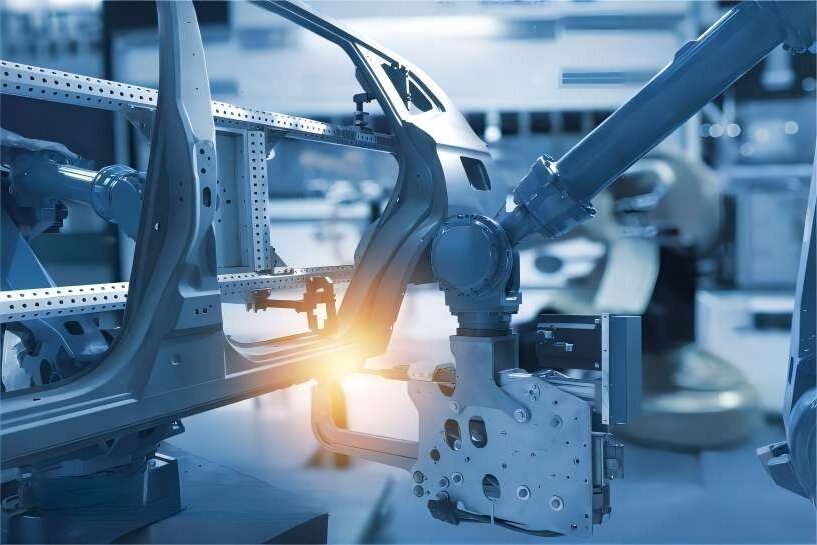
عوامل التكلفة في تصنيع الصفائح المعدنية للسيارات
تعتمد تكلفة تصنيع الصفائح المعدنية للسيارات على عدة عوامل. يمكن أن يساعد فهم هذه العوامل المصنعين على التخطيط بشكل أفضل وإدارة النفقات.
المواد وتأثيرها على التكاليف
تلعب المواد المستخدمة دوراً هاماً في تحديد التكلفة الإجمالية. فالمعادن مثل الفولاذ المقاوم للصدأ والتيتانيوم أغلى من الألومنيوم أو الفولاذ المدلفن على البارد.
قد تكلف المواد الأقوى والأخف وزناً أكثر ولكنها غالباً ما توفر أداءً ومتانة أفضل. وفي حين أنها تزيد من التكلفة الأولية، إلا أنها يمكن أن توفر قيمة على المدى الطويل.
العمالة والتكاليف التشغيلية
تشير تكاليف العمالة إلى أجور العمال الذين يشغلون الماكينات ويتولون عمليات التصنيع. وغالباً ما يحصل العمال المهرة، مثل عمال اللحام والمهندسين، على أجور أعلى.
تغطي التكاليف التشغيلية أشياء مثل صيانة المصنع واستخدام الطاقة والنقل. يمكن أن تتراكم هذه التكاليف، خاصةً عندما تكون عملية الإنتاج معقدة أو تنطوي على أحجام كبيرة.
الاستثمار في الآلات المتطورة
قد يكون الاستثمار في الماكينات المتقدمة، مثل آلات القطع بالليزر أو آلات اللحام الآلية، مكلفًا في البداية. ومع ذلك، تعمل هذه الماكينات على تحسين سرعة الإنتاج ودقته.
فهي تقلل من الأخطاء والهدر، مما يؤدي إلى انخفاض التكاليف بمرور الوقت. في حين أن الاستثمار الأولي مرتفع، إلا أن مكاسب الكفاءة يمكن أن تجعلها خيارًا ذكيًا للإنتاج بكميات كبيرة.
خاتمة
يتضمن تصنيع الصفائح المعدنية للسيارات العديد من العمليات الرئيسية، بدءًا من القطع والتشكيل وحتى وصل الأجزاء المعدنية. وتعد كل خطوة ضرورية لإنشاء مكونات سيارات قوية ومتينة. يؤثر كل من اختيار المواد وتكاليف العمالة والآلات المستخدمة على السعر النهائي. من المهم الموازنة بين الجودة والتكلفة لضمان الحصول على أفضل النتائج.
اتصل بنا اليوم إذا كنت تريد تصنيع ألومنيوم عالي الجودة لمشاريع السيارات الخاصة بك. يمكننا مساعدتك في إضفاء الحيوية على تصميماتك بدقة وكفاءة. اتصل بنا الآن للحصول على عرض أسعار!
مهلا، أنا كيفن لي

على مدى السنوات العشر الماضية، كنت منغمسًا في أشكال مختلفة من تصنيع الصفائح المعدنية، وشاركت رؤى رائعة هنا من تجاربي عبر ورش العمل المتنوعة.
ابقى على تواصل

كيفن لي
لدي أكثر من عشر سنوات من الخبرة المهنية في تصنيع الصفائح المعدنية، وتخصصت في القطع بالليزر، والثني، واللحام، وتقنيات معالجة الأسطح. كمدير فني في شنغن، أنا ملتزم بحل تحديات التصنيع المعقدة ودفع الابتكار والجودة في كل مشروع.



